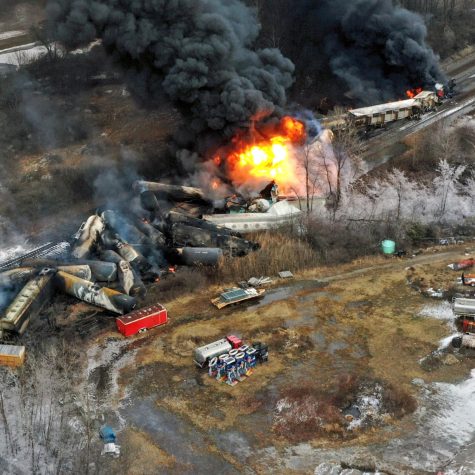A Rapid Responsibility: Overpopulation and the Environment
January 23, 2022
The Earth’s total population is nearing eight billion people, and roughly three hundred thousand people are born each day. With the population increasing so rapidly, how does the Earth keep up with our growing demand?
The obvious answer is we won’t be able to live comfortably on an overpopulated Earth. Our Earth can only hold a certain amount of people before causing environmental degradation, or the loss of biological diversity in the environment. But before tackling the problem of overpopulation, one must understand the effects the issue will have in the future. Mr. Seth Garrett, a biology teacher at Belleville West, also teaches our school’s environmental science class. This class discusses many topics, from global climate change to the science of our soil.
“As populations grow, waste follows. Fossil fuel combustion creates waste on many levels. The first is our extraction of those fuels from the Earth’s crust and carbon dioxide accumulation in our atmosphere follows when we burn them as fuel,” says Mr. Garrett.
The burning of fossil fuels is one of the many direct causes of climate change on Earth. In other words, the more people there are on Earth, the need for the burning of fossil fuels goes up, and this would in turn cause global temperatures to go up. Many are aware that climate change is happening right now, but what about overpopulation? Is it too late for us?
“In terms of our population count, no one is really sure how close to the ceiling we are. However, if we keep burning fossil fuels at the rate at which we are, that ceiling will be met rather quickly,” Mr. Garrett states. “However, if more sustainable means of obtaining energy are utilized in the near future, the Earth may be able to support more people than we ever thought possible.”
Earlier this year, Mr. Garrett’s environmental science class discussed overpopulation, its effects on Earth, and how it all starts. In short, it all begins with food.
“An abundance of food will cause a population boom,” says environmental science student Christina Cruse. “If they have enough resources, then they’re going to have a lot of children, and as medicine gets better, those kids are going to live a lot longer, too.”
So, if life expectancy rises as the population grows, then there will be a big problem. People will be having many kids while the majority of the world’s elderly population is still alive. We share this Earth with other species. How does our problem affect them?
Mr. Jared Hemmer, who teaches veterinary science, says, “Because there are more people living on this planet now than ever before, we are constantly destroying forests and habitats along with it. This is because of the need we have for fiber and lumber to assist with the population and its growth. By doing this we have caused more plant and animal species to go extinct. This is a direct cause of overpopulation and humans are at fault. It is estimated that nearly 20 plant and animal species are going extinct every hour.”
Although it is very important and crucial for our existence to keep other species alive, there are many humans in other countries that are struggling due to overpopulation. In developing countries, overpopulation causes poverty, disease, and unsanitary and overcrowded cities. These countries continue to have a growing population despite their accommodating situation.
“There are many reasons why developing countries have faster population growth,” says Mr. Bob Flake, head of the Belleville West science department. “First, in an agricultural-based society, children mean free labor or help in the farm fields. Also, since children have to work instead of going to school, like in industrialized countries, many times women are encouraged (or forced) into marriage at much younger ages. Developed nations usually do not have good healthcare systems, so access to birth control is not widely available.”
Women who marry at younger ages have a much wider fertile window, meaning that they can have more children throughout their lifetime. For example, the average woman in Niger marries at the age of fifteen and has an average of seven children. On the contrary, the average woman in Norway marries at thirty-one and has about two children. It is a huge difference, and it is only a matter of what state a country is in regarding its development.
“There are many things that we can do to support developing nations,” continues Mr. Flake. “There are many programs/organizations that have the goal to help developing nations/worldwide overpopulation. Many of these organizations take donations to help food banks, increase medicine, or give people better access to clean water to people in developing countries. The US government also has programs that give aid/help other countries. The United Nations do the same as well. It is in everyone’s best interest to help these countries become industrialized and increase the quality of life for all people!”
This issue isn’t just one country’s problem. One day we might all have to face the consequences of our actions. If we can’t slow down the population growth, or at the very least switch to renewable energy sources that can support a large population, the consequences will be devastating for every species on Earth.
However, Mr. Garrett reassures: “Overpopulation isn’t a mistake. Reproduction is part of nature and it will continue as long as our species exists. However, greater numbers create great responsibility. We need to treat Earth and its resources responsibly moving forward or the next several generations will pay the price.”









